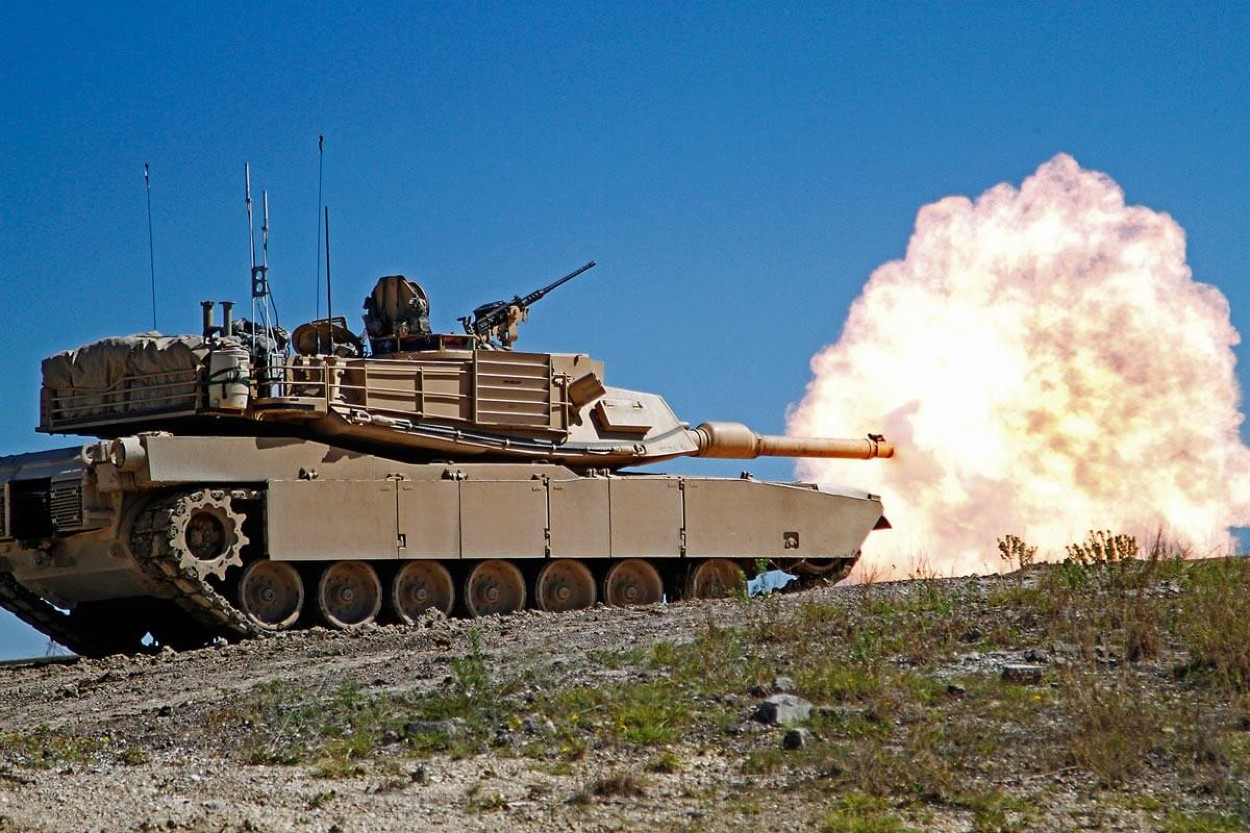Chinese scientists have conducted comprehensive tests on the potential of kinetic energy weapons (KEWs) against US military tanks, revealing the possibility of a single shot disabling a tank even without visible external damage.
According to Chinese media, researchers concluded that a 20kg solid sphere moving at four times the speed of sound could pose a significant threat to advanced tanks meeting US military standards.
The kinetic energy carried by such a projectile amounts to approximately 25 megajoules, a seemingly substantial figure that, when converted to electrical energy, equates to just over 7 kilowatt-hours.
This energy, though seemingly modest, could cause irreparable damage to the inner workings of a tank, even if the external appearance remains unscathed, the report claimed.
The Chinese researchers refrained from explicitly naming the US tank but mentioned that the energy discussed would be sufficient to damage a 40-60-tonne US-operated tank, such as the Abrams tank.
The team discovered that critical components, such as bolts connecting essential equipment to the inner cabin wall, could fracture upon impact, rendering the tank inoperable.
Published in the peer-reviewed journal Equipment Environmental Engineering on December 8, the findings underscore the vulnerability of traditional military hardware in the face of evolving weapons technology.
The Chinese researchers said that high-speed kinetic projectile impact could lead to failure in specific locations of armored targets, surpassing safety limits recommended by the US military standard MIL-STD-810.
MIL-STD-810, also known as Military Standard 810, comprises a collection of testing techniques and protocols developed by the United States Department of Defense (DoD) to evaluate the durability and resilience of equipment.
The primary goal of MIL-STD-810 is to guarantee that military hardware remains operational under diverse conditions it might face throughout its use. In the context of the increasing use of hypersonic weapons, defense systems often lack the reaction time needed to counter such high-speed attacks.
Unlike traditional anti-tank weapons relying on gunpowder, high-speed kinetic projectiles have the potential to inflict lethal damage even with grazing contact. The launching methods for these projectiles are diverse, expanding their utility in various scenarios.
The Chinese team also found that assessing the damage caused by kinetic projectiles differs significantly from evaluating conventional armor-piercing rounds.
While conventional rounds can be tested using a piece of alloy armor, kinetic projectile testing necessitates considering the entire tank due to the complex shock wave generated upon impact. This shock wave can lead to stress concentration in areas like bolts, causing distortion or fracture.
Revolutionizing Warfare
Kinetic energy projectiles leverage high terminal speeds to impart significantly more energy onto a target than the inherent energy from the chemical explosives they carry.
Tank crews often position the front of the vehicle toward potential threats, aiming to leverage its rugged design. However, a kinetic projectile hitting this section could transmit destructive stress into the tank’s interior, jeopardizing firepower capabilities.

The researchers noted potential consequences, such as the tank gun stabilizer console losing grip, the console’s wiring base being completely pulled out, and severed connections between the fire control computer and the turret, resulting in a substantial loss of firepower.
Meanwhile, amid the escalating race to advance hypersonic weapons, the potential development of hypersonic kinetic-kill anti-tank munitions seems likely.
Interestingly, the US Army was actively engaged in this pursuit, dedicating extensive resources over several decades to develop hypersonic kinetic-kill anti-tank missiles.
Lockheed Martin, a US-based company, was actively developing the Compact Kinetic Energy Missile (CKEM) to outfit specific variants of the FCS family of vehicles, along with established platforms like the tracked Bradley Fighting Vehicle and the wheeled Stryker armored vehicle.
The CKEM garnered recognition for its perceived lethality in Line-of-Sight engagements. In a notable milestone in 2007, Lockheed Martin successfully tested the CKEM against a static T-72 tank, showcasing its capabilities.
The successful test against a T-72 tank equipped with explosive-reactive armor demonstrated that the CKEM, with its kinetic energy focus, could effectively neutralize a target even when faced with advanced protective measures.
However, the trajectory of the CKEM project took a turn when the Pentagon decided to terminate the Army’s Future Combat Systems (FCS) program in 2009.
This decision not only marked the end of the FCS initiative but also effectively halted the progression of the last known high-speed anti-tank missile project, putting an abrupt halt to the promising developments of the CKEM.
Thus, within the past decade, public discourse on this concept has notably diminished, raising questions about the current status of such initiatives.
Despite the apparent decline in public attention, the study conducted by China indicates ongoing interest and research in hypersonic kinetic-kill anti-tank technology, suggesting that the concept remains a subject of strategic consideration, particularly in the context of the evolving landscape of great power competition.
Overall, the concept of a hypersonic anti-tank missile, characterized by speeds exceeding Mach 5, coupled with a kinetic penetrator, can potentially be a transformative and game-changing anti-tank capability.
- Contact the author at ashishmichel@gmail.com
- Follow EurAsian Times on Google News